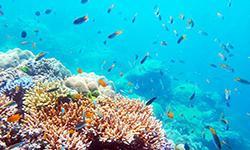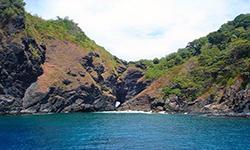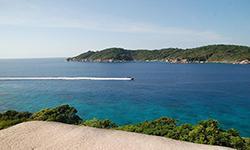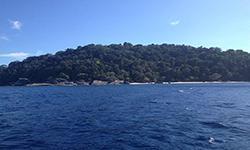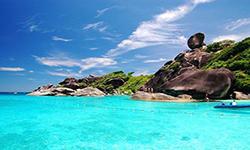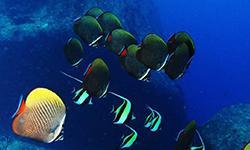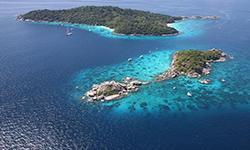Mu Ko Similan National Park
Contact Location : Mu Ko Similan National Park, 93 Moo 5, Lam Kaen Sub-district, Thai Mueang District, Phang-Nga Province, 82210
Telephone Number : (+66) 7 645 3272, (+66) 7 645 3273
Email : np_similan@hotmail.com
Facebook : Mu Ko Similan National park
Information
Mu Ko Similan National Park is located between latitude 8 degrees 28 minutes to 9 degrees, 15 minutes north, and longitude 97 degrees to 97 degrees 50 minutes east in the Andaman Sea. The Mu Ko Similan National Park is reached via Thap Lamu Pier, Thai Mueang District, Phang-Nga Province, which is about 70 kilometers away, and from Hat Patong Pier, Kathu District, Phuket Province, which is about 90 kilometers.
Mu Ko Similan was declared Thailand’s 43rd national park in 1982, with an area of 128 square kilometers or 80,000 rai. In 1988, ”Ko Ta Chai" was annexed to add 12 square kilometers to the park. The islands and sea have fertile coral reefs in Ko Phra Thong, Kuraburi District, Phang-Nga Province, and covers an area of approximately 140 square kilometers, or 87,500 rai. The island areas cover about 26 square kilometers, or 16,250 rai, with the rest part of eastern Andaman Sea. The submerged shoreline is encountering tremendous erosion by the sea, so the 9 islands have unique topography with various irregular shapes. The rock found in the Mu Ko Similan National Park is igneous rock, namely granite, which is aged as from the Tertiary-Cretaceous period, about 65 million years ago.
Background
"Similan" is a Yawi or Malay language word meaning "nine." The Mu Ko Similan, or Ko Kao, consists of nine islands positioned from north to south, namely Ko Bon, Ko Bangu, Ko Similan, Ko Payu, Ko Ha, Ko Miang, Ko Payan, Ko Payang, and Ko Huyong.
Mu Ko Similan was declared Thailand’s 43rd national park in 1982, with an areaof 128 square kilometers or 80,000 rai. In 1988, ”Ko Ta Chai" was annexed to add 12 square kilometers to the park. The islands and sea have fertile coral reefs in Ko Phra Thong, Kuraburi District, PhangNga Province, and covers an area of approximately 140 square kilometers, or 87,500 rai. The island areas cover about 26 square kilometers, or 16,250 rai, with the rest part of eastern Andaman Sea. The submerged shoreline is encountering tremendous erosion by the sea, so the 9 islands have unique topography with various irregular shapes. The rock found in the Mu Ko Similan National Park is igneous rock, namely granite, which is aged as from the Tertiary Cretaceous period, about 65 million years ago.
Note : After paying the entrance fee to the National Park, please carry the receipt for inspection.

875,00 rai (140 Square kilometers)
|
|
|
|
|
|
|
|
|
|
|
|
|
|
|
|
Nature trails ⇔ Observe flowers/plant ⇔ Bird/Butterfly ⇔ Snorkeling ⇔ Scuba diving
Welfare shop : (souvenirs, coffee, drinks, snacks): open daily from 7.00 - 20.00 hrs.
National Park Headquarter area: AIS, TRUE, DTAC
Area of Ko Payu (Ko 7): AIS, TRUE
Ko Miang (Ko 4): AIS, TRUE
Ko Similan (Ko 8): DTAC
Ko Ha area: AIS, TRUE
Thap Lamu port area: AIS, TRUE, DTAC
Ko Hok area: AIS, TRUE
|
|
The Mu Ko Similan National Park consists of steep granite hills, sandy beaches, and various shapes of rocks. The island's coast has a dented and irregular appearance formed by the sea, which erodes the island through waves which predominantly move in a north-south direction. The water surface is part of the Andaman Sea, which is in the eastern Indian ocean. The continental shelf borders the west coast of Phang-Nga Province and Burma, parallel to the Nicobar Islands, which are on the continental shelf of India. There is no muddy soil on the beach or dunes; therefore, the beach is clean and has fine sand particles. The top of the mountain is steep, with a peak at 244 meters above sea level. Some of the islands are flat and surrounded by dunes and coral reefs.
|
|
Summer runs from mid-February to May and the rainy season runs from mid-May to October. - The average temperature throughout the year is 27 degrees Celsius. - The relative humidity is high, with an average throughout the year of about 83%. - The average annual rainfall is 3,560 mm. - The amount of average annual evaporation is 1,708 mm. - During the rainy season, the southwest monsoon may cause heavy rain and strong waves. Traveling to the Mu Ko Similan National Park during this period is not safe for visitors. The scheduled seasons are as follows: - Close tourist season from May 16 to October 14 of every year. - Open tourist season from October 15 to May 15 of every year.
|
|
|
|
The beach forest is a sparse forest with scattered plants that are less than 15 meters tall and include Tropical Almond, Fish Poison Tree, and Alexandrian Laurel. Small perennial plants and large shrubs with a height of less than 10 meters are found, such as Xylocarpus rumphii (Kostel.) Mabberley, Heritiera littoralis Aiton, and Coast Cotton Tree. There are also small shrubs such as Capparis micracantha DC, Breynia reclinata (Roxb.) Hook.f, and Seashore Screwpine. Ground cover plants found are beans, Phaseolus semierectus., Para Cress, and 2. Grove wood is a group of shrubs that grow on thin soil that is less than 30 centimetre deep. Plants found are not very dense, and include Torch Thistle and Dracaena loureiri Gagnep. Commonly found small shrubs are Memecylon garcinioides Blume and Cleistanthus helferi Hook.f. 3. tropical rain forest has large perennial plants that are 20 meters tallor more, such as Dipterocarpus costatus, Siamese Rosewood, and Shorea curtisii Dyer ex King. Trees in the understory with a height of 15–20 meters include Palaguium obovatum, Syzygium grande (Wight) Walp., Wrightia Tree, and medium-sized perennial plants of 10–15 meters height are Chaulmoogra, Semecarpus curtisii King, and Diospyros diepenhorstii. Lower ground plants found include wild bamboos, rattan, palms, Ivy, and vines such as Ceriman and Bauhinia saccocalyx. In addition, orchids and parasite plants are found on large branches. In Mu Ko Similan National Park, rare plants like Manilkara littoralis (Kurz) Dubard and Heliotropium arboreum (Blanco) Mabb. only on the large islands. The edible plants found include Manilkara littoralis (Kurz) Dubard, Bouea oppositifolia (Roxb.) Meisn., Lepisanthes rubiginosa (Roxb.) Leenh., Djenkol Bean, Melientha suavis Pierre, and Capparis micracantha DC. Wild animals discovered in the survey include: Mammals: Most of the mammals found were small, such as the Island Flying-Fox, the Black-Bearded Tomb Bat, and the Black Giant Squirrel. The largest mammal found was the Bottlenose Dolphin. Repyiles include sea turtles, with the most important species being the Leatherback Sea Turtle and the Hawksbill Sea Turtle. Other reptiles include Bengal Monitors and Squirrels non-venomous snakes such as Reticulated Pythons. Birds that are commonly found in National Park areas include non-migratory birds, such as Brahminy Kite and White-Breasted Waterhen. Migratory winter visitors to Thailand include the Pin-Tailed Snipe and the Grey Wagtail. The endemic birds that sometimes migrate include the Barn Swallow, Cattle Egret, Watercock, and Roseate Tern. The critical fish species found around the islands include sharks, Blue Marlin, stingrays, flying fish, and Puffer Fish. Coral reef fish include Butterfly Fish, Angel Fish, and many other economically valuable fish. The most important species of invertebrates are corals and jellyfish. The corals surrounding the Mu Ko Similan are mostly deep-water corals such as Leaf Corals, Bottlebrush Corals, and porous corals, including coral colonies, sponges, and soft corals. |
How to get there by car :
From Bangkok, drive along Highway No. 4, Ranong - Takua Pa - Phang-Nga Road, through Takua Pa District until reaching Ban Lam Kaen. There is a three-way intersection. Turn right to Thap Lamu Pier, which is about 5 kilometers away. From Thap Lamu Pier, take a boat to Ko Si (Ko Miang), is the location for Mu Ko Similan National Park Headquarters. The journey time is approximately 1 hour 30 minutes.
How to get there by planes:
From Bangkok Airport, arrive at Phuket Airport, then travel to Phang-Nga Province by bus or van to Thap Lamu Pier, a distance of about 100 kilometers.
How to get there by bus:
Travel from the Southern Bus Terminal on the Ranong - Phang-Nga line, getting off at the Thap Lamu Pier junction, and then taking a taxi to the pier.
How to get there by boat:
From Thap Lamu Pier, travel to Ko Si (Ko Miang), where the National Park Ranger Station So Lo No. 1 (Ko Miang) and National Park Ranger Station So Lo No. 2 (Ko Similan) are located. It is a distance of about 70 kilometers. Private boats and speedboats are available daily, but are most available throughout the high season (October 15–May 15), when passenger boats leave the port regularly. A scheduled ferry travels from Thap Lamu Pier to the island between 8 and 9amand returns at 3pm. The journey time is approx. 1 hour 30 minutes on the speedboat if you go direct, but some boats may stop at various islands. The fare and what is included depends on the type of boat. The national park does not have a boat service as provision is well-provided by private companies
- National Park Ranger Station So Lo No. 1 (Ko Miang)
- National Park Ranger Station So Lo No. 2 (Ko Similan)
- National Park Ranger Station So Lo No. 3 (Ko Ta Chai)
-

